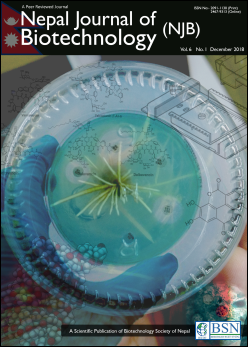Hepatitis B and C Virus Infections among Blood Donors in Blood Transfusion Center, Pokhara, Nepal: Seroprevalence and its Associated Risk Factors
DOI:
https://doi.org/10.3126/njb.v6i1.22335Keywords:
Blood transfusion, Sera, HCV, HBV, ELISA, NepalAbstract
Hepatitis B Virus (HBV) and Hepatitis C Virus (HCV) infections lead to chronic diseases and are the most common causes of liver cirrhosis and cancer in developing countries like Nepal. The study is carried out to determine the seroprevalence of HBV and HCV by using a Rapid kit method and Elisa Method to find out its risk factors. The cross-sectional study was done among blood donating people from 16th August 2016 to 19th November 2016. Blood donors in Pokhara Valley were screened for anti-HCV antibodies, anti-HBV antibodies using third generation ELISA kits and automated ELISA Processor in serology laboratory at Central Blood Transfusion Service (CBTS) of Nepal Red Cross Society (NRCS) in Pokhara, Nepal. 1777 (87.2%) units were male blood donors and 260 (12.6%) units were female donors out of 2037 participants. Gender wise, the ratio between male and female was 1:0.1. HBV and HCV infection rate in blood donors were detected at 0.7% (15/2037) and 0.5% (8/2037) respectively. HBV infection rate in volunteer blood donor people was 0.7% (14/1881) which was higher than the replacement donors i.e. 0.6% (1/156). Similarly, in HCV infection rate in volunteer donor were 0.4% (8/1881). HBV infected people are detected higher than the HCV infected people among the blood donors. In addition, there was no significant relationship between positive results of HBV and HCV tests with the gender, age, tattoo, donor type.
Downloads
Downloads
Published
How to Cite
Issue
Section
License
Copyright Notice:
The manuscript submitted to NJB must be an original contribution, not previously published and should not be under consideration for publication elsewhere. When the manuscript is accepted for publication, the authors agree to automatically transfer the copyright of the article to the publisher. It should grant permission to any third party, in advance and in perpetuity, the right to use, reproduce or disseminate your article, according to the NJB copyright and license agreement.
Authors transfer copyright to the publisher as part of a journal publishing agreement but have the rights to: Share their article for Personal Use, Internal Institutional Use and Scholarly Sharing purposes, with the NJB applies the Creative Commons Attribution-NonCommercial CC BY-NC license to all the works we publish after Jun 2020 (Before it was CC BY-NC-ND). Under this license, authors agree to make articles legally available for reuse, without permission or fees, for virtually any non-commercial purpose. Anyone may remix, adapt, and build upon your work non-commercially, and although their new works must also acknowledge you and be non-commercial, they don’t have to license their derivative works on the same terms. More details on CC BY-NC refer to its Licence Deed and Legal Code.






